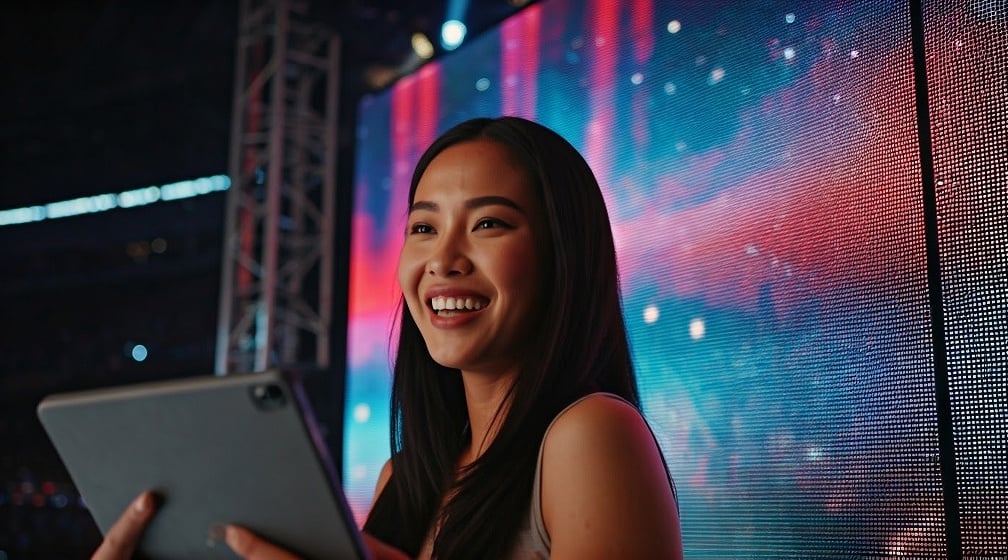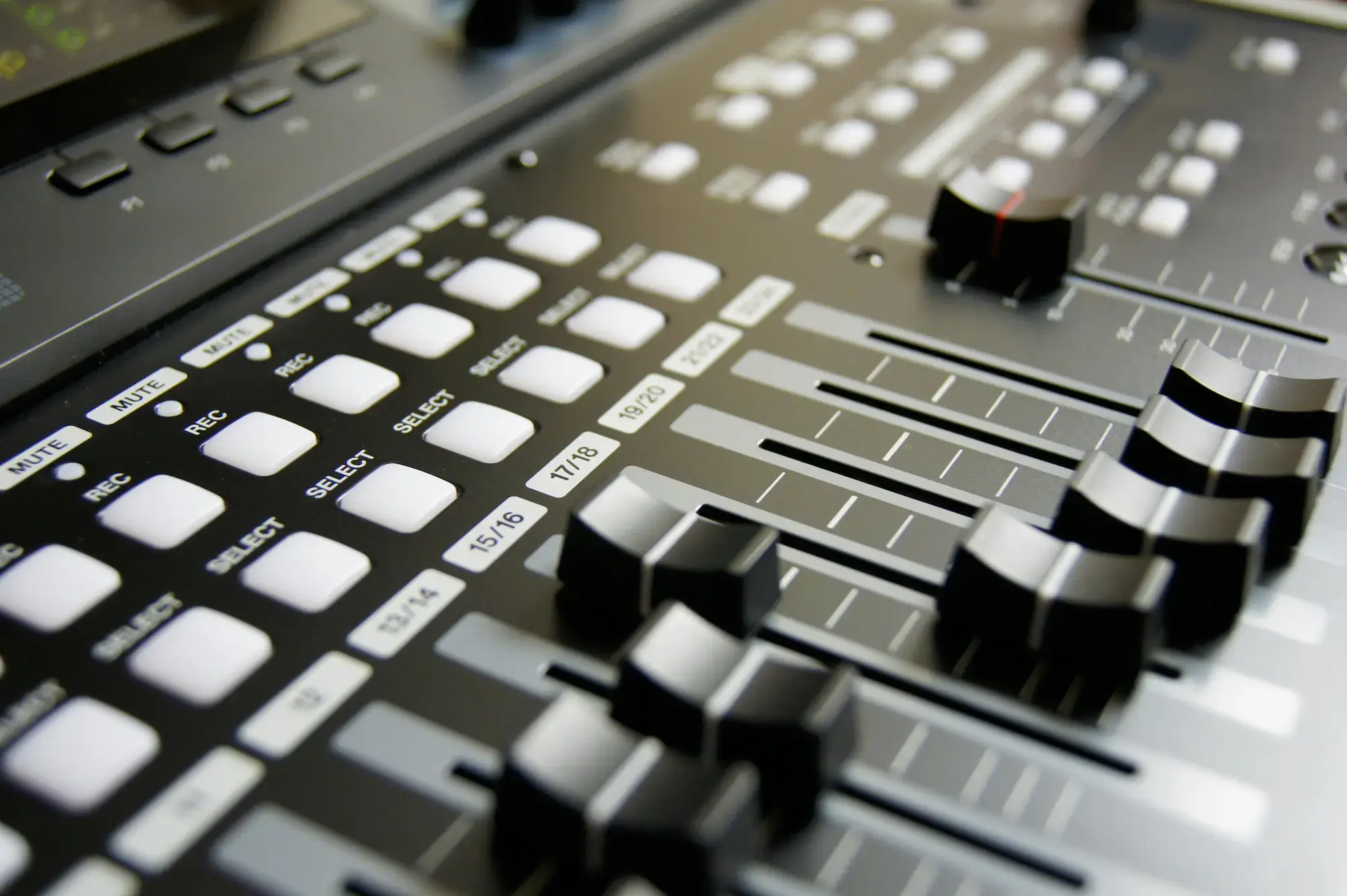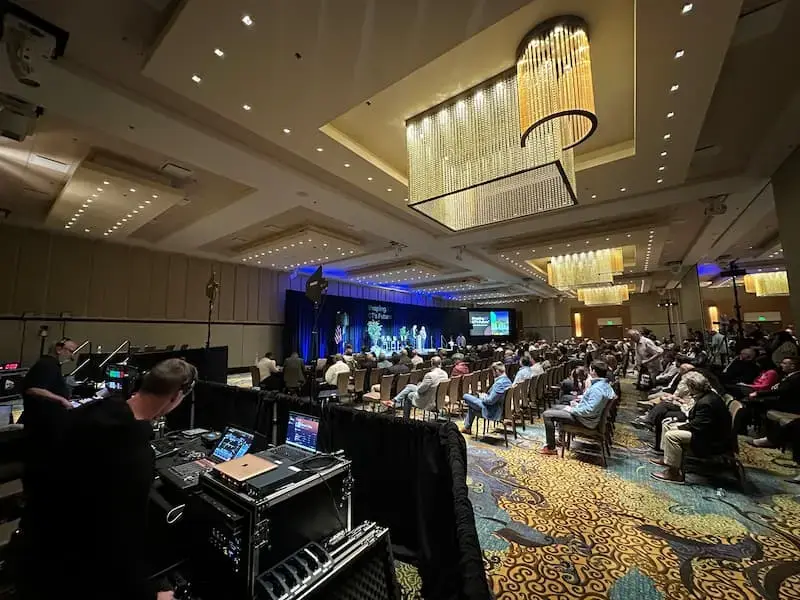What Is an LED Wall?
An LED wall is a modular video display system made up of LED (Light Emitting Diode) panels. These panels tile together to form a seamless, large-format screen capable of displaying vibrant, high-resolution content.
Unlike video monitors or projection systems that rely on backlights or reflectivity, LED walls emit their own light, resulting in rich color saturation and superior brightness. This makes them ideal for both indoor and outdoor use, offering a level of visual performance that traditional displays struggle to match.
LED walls use direct-view LED technology, meaning the LEDs themselves emit the light and color viewed on the screen—allowing for precise control over contrast, color consistency, and image sharpness. Panels are arranged into custom configurations depending on the event’s needs, from a flat rectangular screen to curved or floor-to-ceiling designs.
LED technology is continuously evolving, with newer models offering features like HDR (High Dynamic Range), higher refresh rates, and better color uniformity. These advancements make LED walls even more suited for high-end corporate productions, concerts, and hybrid digital events where visual storytelling is key.
Common Terms to Know:
- Pixel Pitch: The distance between pixels, measured in mm. Lower numbers mean higher resolution and better clarity.
- LED Panel: Each panel consists of a frame, modules that hold the LEDs, a controller and a power supply. A half-panel is 500x500mm, and a full panel is 500x1000mm.
- Video Wall: A General term for large visual displays made from multiple LED panels used to display synchronized content.
- Resolution: the total number of pixels that the Video Wall contains. Expressed as width x height (e.g.: 1920x1080, which is HD)
- Aspect Ratio: Aspect ratio is the proportional relationship between the width and height of a shape. It describes how wide something is compared to how tall it is, regardless of the actual size—so a 16:9 aspect ratio could apply to a small phone screen or a large LED Wall
Key Benefits of Using LED Walls at Events
Exceptional Visibility & Brightness
LED walls shine in both literal and figurative ways. They remain visible even in broad daylight, making them ideal for outdoor events like festivals, sports, or open-air presentations. The important specification is Nits, which is a unit of brightness. For reference, in an indoor, controlled environment, you will need 600-1,000 nits for comfortable viewing. As the ambient light increases or you move outdoors to direct sunlight, that requirement increases dramatically.
Their high-brightness capabilities of LED Walls, which can exceed 4,500 nits, ensure content stays sharp and easy to see from long distances, enhancing the experience for large audiences.
The brightness can also be dynamically adjusted up or down, which is helpful when transitioning between day and night sessions or managing indoor lighting conditions.
Flexible Size & Shape Customization
Thanks to their modular structure, LED walls can be configured in various sizes and shapes:
- Wrap-around architectural columns
- Form curved or 3D-style immersive displays
- Scale from small signage to full-stage video backdrops
- Be assembled into ultra-wide, or ultra-tall shapes
- Be used as floors or ceilings - not just walls
This adaptability means LED walls can be seamlessly integrated into any event space—whether it’s a sleek corporate venue or a sprawling festival ground. The ability to custom-fit LED walls into unconventional spaces can make the overall aesthetic more cohesive and impressive.
Immersive & Dynamic Visuals
From traditional to unique, consider visual options like:
- Used as a traditional display, showing presentation graphics or video feeds from cameras
- Animated motion graphics - turning the LED Wall into a giant dynamic mural
- Smaller windows or Picture-in-picture layouts that can highlight video or content in almost any position on the wall
- Immersive video content that reflects the event theme or your company brand
This multimedia functionality allows for storytelling that evolves throughout the event, keeping the audience engaged and entertained. The visuals can change from one style to another as the event progresses.
Indoor & Outdoor Versatility
Outdoor LED Panels are IP-rated, meaning that they are built with durable housings that withstand rain, wind, dust, and extreme sunlight. These panels are engineered to remain operational even in challenging environments. As the outdoor wall gets larger, special consideration will be needed for the support and superstructure. Outdoor panels can be used indoors, but not vice versa.
For indoor setups, LED wall brightness can be dialled up or down depending on the ambient light in the space. Indoor setups still require superstructure and ballast, but wind and rain are no longer considered (thankfully!).
Whether you’re organizing an elegant indoor awards gala or an outdoor product activation, there’s an LED wall solution that fits.
Content Planning for LED Walls
It’s critical to consider the size, shape (aspect ratio) and resolution (total pixels) of the LED Wall and design the content to fit the canvas. As mentioned, you can display any kind of visuals on the wall, but you have to design those visuals to the specifications of the wall.
A normal High Definition video has an aspect ratio of 16:9 and resolution of 1920x1080. If you build a very tall, narrow wall or a super wide wall, that video will only occupy a portion of the image area. As the LED Wall resolution increases, special playback and/or video switching equipment may be necessary to deliver content to the system.
Technical Considerations When Using LED Walls

Power Requirements
LED walls use a ton of electricity. Most venues need a dedicated power panel for the AV crew to plug into. For example, each square meter of LED requires approximately 600W of power. A wall covering the entire back of your stage could require a 150 Amp service or more. Your production team can figure out the exact power needs and sort out a solution with the venue. In some cases, if customers want to bring a video wall into a setting with limited power, a generator could be required.
Weight & Structural Load
These walls are heavy. One square meter of LED weighs approximately 80 pounds. If it’s standing on the floor, you’ll need sturdy trusses, bracing, and ballast to keep it steady. If it’s hanging from the ceiling, the venue has to support that weight, so double-checking is a must. Note that the ballast can greatly exceed the weight of the LED Wall itself when setting up outdoors.
Setup Time & Crew Requirements
Compared to a traditional video projection screen, LED walls can take longer to put up as the crew needs to handle the superstructure, ballast and carefully align each LED Panel in your wall. Taking it down is slower too; LED walls need careful disassembly.
Pixel Pitch & Resolution
As mentioned above, the Pixel Pitch is the distance between each pixel in mm. When using ultra-fine pitches (less than 1.9mm), the viewing distance decreases and the resolution increases. Many outdoor systems have pitches greater than 5mm. In that case, the viewing distance increases and the resolution decreases.
A good rule of thumb is to measure the distance from the LED wall to the nearest viewer and divide by 8 to determine your optimal pitch. For example, if the audience starts at 24 feet, use a pitch of 3mm or less. In this example, if you use a higher pitch, the image may appear grainy to the front rows, but will look great to those seated further away.
Generally speaking, ultra-fine pitches are most expensive, with the price decreasing as the pitch increases.
|
Rule of Thumb |
||
| Pixel Pitch | Minimum Distance | Resolution of a 17' x 10' wall |
| 1.9 | 15 | 2560x1536 |
| 2.6 | 21 | 1920x1152 |
| 3.1 | 25 | 1600x960 |
| 3.9 | 31 | 1280x768 |
| 5.0 | 40 | 936x520 |
| 8.0 | 64 | 648x360 |
Choosing the right pitch is crucial for avoiding pixelation or over-investment in resolution where it’s not needed.
Brightness, Contrast & Refresh Rate
- Brightness (nits): Outdoor displays often require 4,000–6,000 nits, while indoor models range from 800–1,200. LED wall brightness can be adjusted to adapt to shifting ambient lighting conditions.
- Contrast Ratio: High contrast ratios enhance depth and color vibrancy, making visuals more impactful, especially for darker or moodier scenes.
- Refresh Rate: A refresh rate of 3,840 Hz or higher is recommended. Higher rates prevent flickering, critical for events being filmed or live-streamed, while lower ranges may be sufficient for indoor or static applications.
Viewing Angle
A quality LED wall offers wide viewing angles (140° or more), ensuring attendees from all sides of the venue have a clear and immersive view. This is especially beneficial in large or irregularly shaped event spaces where audiences aren’t all facing the stage directly.
Latency & Syncing
Latency is the delay between the live action captured by the camera and the video shown on the LED Wall. The latency is caused by the video switching system and the LED Wall processor. Different systems will perform differently, so it’s important to discuss with your production team when planning your content.
High latency appears as a delay, sometimes referred to as “lip sync” where the sound does not match the lips of the performer on screen.
Popular Event Applications of LED Walls

Conferences & Keynotes
LED walls are a favourite for high-impact corporate events. They:
- Serve as cinematic backdrops for the main stages
- Provide enhanced speaker visibility
- Show dynamic transitions between sessions or segments
- Easily change the overall background or theme of the stage
- Display different content windows across a wide digital canvas
Trade Shows & Exhibits
In bustling exhibit halls, LED walls help booths stand out by:
- Playing looping demo reels and 3D product videos
- Displaying brand logos at scale
- Allow you to use one booth design and change the content at different shows
- Supporting live demos and product walkthroughs
- Larger than Video Monitors, and more dynamic than video projection
This draws attention from afar and makes brands look more premium and tech-savvy.
Concerts, Festivals & Sports
LED walls dominate the entertainment scene by:
- Powering massive stage backgrounds with synchronized lighting and visuals
- Scalable technology to increase or decrease the size of the LED Wall depending on the venue
- Enhancing the atmosphere with visuals that match the tempo and tone
Stand-alone LED Walls (off stage) can serve as a dynamic step-and-repeat for attendee selfie moments and can serve as digital signage where needed.
Weddings & Private Events
At weddings, LED walls bring a cinematic flair:
- Photo reels, love story videos, and family tributes
- A large, high-impact screen can display videos, photos, or just serve as a cool backdrop for the event
- Real-time social media displays and guest interaction
Whether for intimate receptions or grand ballrooms, they elevate emotional impact and elegance.
Outdoor Movie Nights & Screenings
Perfect for community events, fundraisers, or drive-in style screenings:
- LED walls offer higher brightness than projectors
- Maintain clarity without needing perfect darkness
- Withstand unpredictable weather without compromise
- LED walls on trailers are easy to roll in and set up quickly
They offer a cinematic experience with reliable performance and easy scalability.
Is an LED Wall Right for Your Event?
Before choosing an LED wall setup, ask yourself:
- What’s the average viewing distance for my audience?
- Will this event take place outdoors?
- What level of ambient light am I competing against?
- What level of visual impact am I aiming for?
- Is my budget prepared for a professional LED investment?
- Will the venue support the weight and power requirements?
- Will the display be visible on livestreams or video recordings?
If your event prioritizes visual impact, branding, and real-time interaction, LED walls are a smart and scalable investment. They serve not just as screens, but as story-enhancing, audience-immersing tools.
Ready to create an unforgettable visual experience?
.jpg?width=2000&name=img%20(1).jpg)



